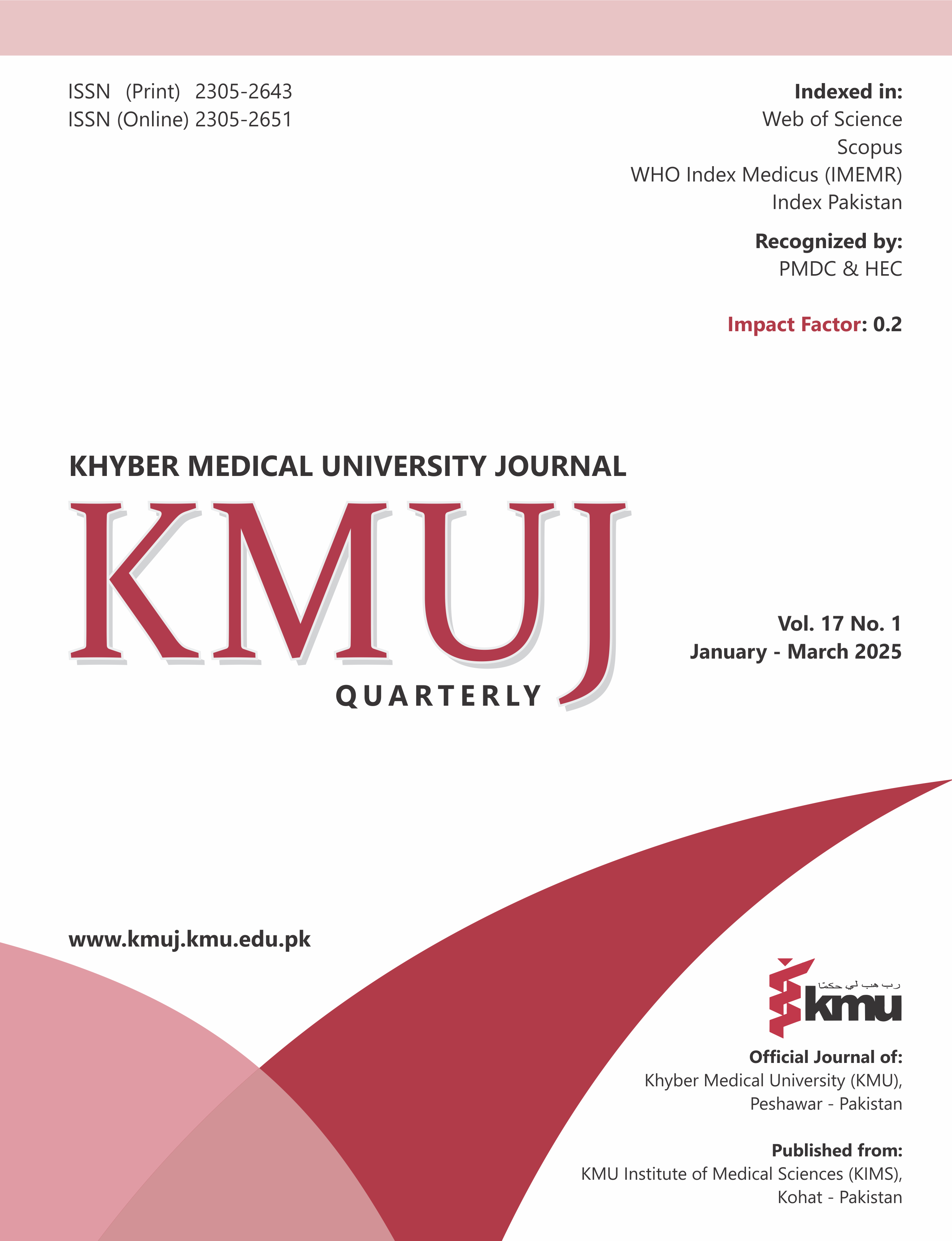Molecular characterization of autosomal recessive Glycogen storage disease type Ib in a Pakistani family
Main Article Content
Abstract
Objective: To investigate Glycogen storage disease GSD type Ib in a Pakistani family through whole exome sequencing (WES) and Sanger sequencing to identify the genetic mutation and confirm its autosomal recessive inheritance.
Methods: This case-control and observational study was conducted at Islamia College University Peshawar, Pakistan, in the laboratory of Center for Omic Sciences in collaboration with Ulm University, Germany within a period of one year. Comprehensive clinical evaluations, comprising radiological examinations and liver function tests, established the diagnosis of GSD in the index patient, who presented with hepatomegaly, oral ulcerations, night tremors, short stature and delayed speech development as compared to her normal age controls and laboratory results indicated hypoglycemia and hyperuricemia. Whole exome sequencing (WES) was performed on the index patient to identify mutations in the SLC37A4 gene, followed by Sanger sequencing of family members to confirm the autosomal recessive inheritance of the recognized mutation.
Results: It is estimated that 80% of GSD-I patients have type I-a and only 20% are affected with type I-b. The analysis revealed a previously reported alteration (c.92-94del; p.Phe31del) in the SLC37A4 gene, found in a homozygous state in the affected sibling, while obligate carriers were heterozygous. The variant was absent in fifty healthy controls from the same ethnic background.
Conclusion: The study highlights the role of WES and Sanger sequencing in the diagnosis of rare diseases like GSD-Ib and recommends genetic testing of close relatives to assess carrier status and guide informed reproductive and clinical decisions in order to prevent recurrence.
Article Details

This work is licensed under a Creative Commons Attribution 4.0 International License.
Work published in KMUJ is licensed under a
Creative Commons Attribution 4.0 License
Authors are permitted and encouraged to post their work online (e.g., in institutional repositories or on their website) prior to and during the submission process, as it can lead to productive exchanges, as well as earlier and greater citation of published work.
(e.g., in institutional repositories or on their website) prior to and during the submission process, as it can lead to productive exchanges, as well as earlier and greater citation of published work.
References
1. Ellingwood SS, Cheng A. Biochemical and clinical aspects of glycogen storage diseases. J Endocrinol 2018;238(3):R131-41. https://doi.org/10.1530/joe-18-0120
2. Derks TGJ, Rijn M Van. Lipids in hepatic glycogen storage diseases : pathophysiology , monitoring of dietary management and future directions. J Inherit Metab Dis 2015;38(3):537-43. https://doi.org/10.1007/s10545-015-9811-2
3. D’souza RS, Levandowski C, Slavov D, Graw SL, Allen LA, Adler E, et al. Danon disease clinical features, evaluation, and management. Circ Hear Fail 2014;7(5):843-9. https://doi.org/10.1161/circheartfailure.114.001105
4. Saudubray JM, Van Den Berghe G, Walter JH. Inborn metabolic diseases diagnosis and treatment. Inborn Metab Dis Diagnosis Treat 2012;1-657. https://doi.org/10.1007/978-3-642-15720-2
5. Ballavenuto JMA, de Oliveira JDD, Alves RJ. Glycogen storage disease type i (Von gierke disease): Report of two cases with severe dyslipidemia. Arq Bras Cardiol 2020;114(4):23-6. https://doi.org/10.36660/abc.20190037
6. Chou J, Matern D, Mansfield B, Chen YT. Type I Glycogen Storage Diseases: Disorders of the Glucose-6- Phosphatase Complex. Curr Mol Med 2002;2(2):121-43. https://doi.org/10.2174/1566524024605798
7. Wang DQ, Fiske LM, Carreras CT, Weinstein DA. Natural history of hepatocellular adenoma formation in glycogen storage disease type i. J Pediatr 2011;159(3):442-6. http://dx.doi.org/10.1016/j.jpeds.2011.02.031
8. Kishnani PS, Austin SL, Abdenur JE, Arn P, Bali DS, Boney A, et al. Diagnosis and management of glycogen storage disease type I: A practice guideline of the American College of Medical Genetics and Genomics. Genet Med 2014;16(11):1-29. https://doi.org/10.1038/gim.2014.128
9. Battaglia M, Pollastri P, Ferraro A, Betoni F. The role of ultrasound-guided needle biopsy in the diagnosis of soft-tissue tumors. J Ultrasound 2007;10(2):59-62. https://doi.org/10.1016/j.jus.2007.03.001
10. Borel F, Mueller C. Alpha-1 Antitrypsin Deciency. Humana New York, NY: Humana Press; 2017. pp-278. https://doi.org/10.1007/978-1-4939-7163-3
11. Chou JY, Mansfield BC. The SLC37 Family of Sugar- Phosphate / Phosphate Exchangers. 1st ed. Vol. 73, Exchangers. Elsevier Inc.; 2014. pp357–382. http://dx.doi.org/10.1016/B978-0-12-800223-0.00010-4
12. Dissanayake VH, Jayasinghe JD, Tilakaratna V. A novel mutation in SLC37A4 gene in a Sri Lankan boy with glycogen storage disease type Ib associated with very early onset neutropenia. J Mol Genet Med 2011;05(01):262-3. https://doi.org/10.4172/1747-0862.1000046
13. Sperb-Ludwig F, Pinheiro FC, Bettio Soares M, Nalin T, Ribeiro EM, Steiner CE, et al. Glycogen storage diseases: Twenty-seven new variants in a cohort of 125 patients. Mol Genet Genomic Med 2019;7(11):1-10. https://doi.org/10.1002/mgg3.877
14. Choi R, Park H doo, Ko JM, Lee J, Lee DH, Hong SJ, et al. Novel SLC37A4 Mutations in Korean Patients With Glycogen Storage Disease Ib. Ann Lab Med 2017;37(3):261-6. https://doi.org/10.3343/alm.2017.37.3.261
15. Han SH, Ki CS, Lee JE, Hong YJ, Son BK, Lee KH, et al. A novel mutation (A148V) in the glucose 6-phosphate translocase (SLC37A4) gene in a Korean patient with glycogen storage disease type 1b. J Korean Med Sci 2005;20(3):499-501. https://doi.org/10.3346/jkms.2005.20.3.499
16. Zhang Y, Sun H, Wan N. Mutation analysis of SLC37A4 in a patient with glycogen storage disease-type Ib. J Int Med Res 2019;47(12):5996-6003. https://doi.org/10.1177/0300060519867819
17. Veiga-da-cunha M, Gerin I, Chen Y tsong, Lee PJ, Leonard J V, Schaftingen E Van. The Putative glucose 6-phosphate translocase gene is mutated in essentially all cases of glycogen storage disease type I non-a. Eur J Hum Genet 1999;7(6):717-23. https://doi.org/10.1038/sj.ejhg.5200366
